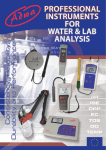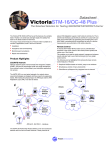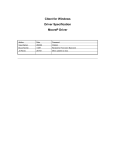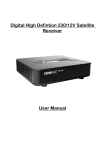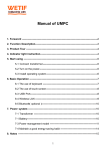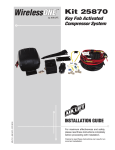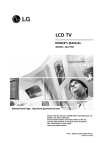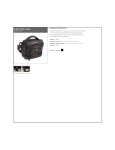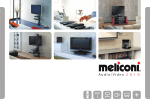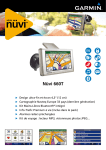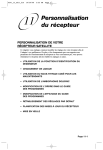Download 1771-2.141, Allen-Bradley Loop Controller Interface Module
Transcript
Allen-Bradley Loop Controller Interface Module (Cat. No. 1771-LIA) Product Data The Loop Controller Interface Module (Cat. No. 1771–LIA) allows PLC–2, PLC–3 and PLC–5 family programmable controllers to communicate with Moore Products Model 352 single–loop PID controllers via the Model 320 Independent Computer Interface. Introducing the Loop Controller Interface Module The loop controller interface module receives generic and controller specific commands from the Programmable Controller (PC) and interprets, verifies, and processes them by generating the necessary link to the loop controllers. The 1771–LIA module can communicate with up to 31 loop controllers through an RS–422 serial link. The Loop Controller Interface Module can: monitor/change setpoint, valve, and operating mode, and acknowledge, set, reset alarms define station address/loop numbers for status reporting to the programmable controller examine/change PID parameters, alarm points, and output limits transfer configuration to a loop controller, programmable controller, or receive a configuration from a programmable controller. Publication 1771-2.141 - June 1989 PN 955104-98 Loop Controller Interface Module (Cat. No. 1771-LIA) Description of the Loop Controller Interface Module The Loop Controller is shown in figure 1. Interface Module commands are shown in table A. Figure 1 Loop Controller Interface Module (Cat. No. 1771–LIA) Table A Loop Controller Interface Module (1771–LIA) Commands Page 2 FUNCTION COMMAND CODE RESPONSE Change the setpoint, output, operating mode, acknowledge, enable, disable alarms SET CONTROL 01H LOOP STATUS Examine PID parameters, alarm limits, and output limits READ PARAMETER 02H READ PARAM ACK Change PID parameters, alarm limits and output limits MODIFY PARAMETER 03H MOD PARAM ACK Transfer a configuration from a station to a 1771-LIA UPLOAD 04H UPLOAD ACK Transfer a configuration from a 1771-LIA to a station DOWNLOAD 05H DOWNLOAD ACK Transfer a configuration from a 1771-LIA to a PC READ CONFIG 06H READ CONF ACK Transfer a configuration from the PC to the 1771-LIA WRITE CONFIG 07H WRITE CONF ACK Sends an ICI command to the ICI ICI COMMAND 08H ICI ACK Loop Controller Interface Module (Cat. No. 1771-LIA) Compatibility The user must be familiar with the terminology, configuration and operation of Moore Products Model 352 Single Loop Digital Controller (SLDC) and Model 320 Independent Computer Interface (ICI). Depending on the application, you must also be familiar with Moore Products Model 321 Local Expansion Satellite (LES). Proper operation of the Loop Controller Interface Module depends upon correct setup of the Model 320 ICI. Set the ICI as follows: Parameter Setup Switch Location ICI link address (see note) serial board SW1, 2 Baud rate 9600 serial board W7 RS-232-C/RS-422 RS-422 serial board W5, W6 Transmission method Binary MPU board SW5 closed Link Acknowledgement Delay Enabled MPU board SW4 open Null filling Enabled MPU board SW3 open Send command security Disabled MPU board SW1, 2 Format 1 start, 8 data, 1 stop, no parity SW2 - 8 off, SW2 - 4 on Note: The 1771-LIA provides an interface with up to 61 Moore Products 352 controllers, depending on the Moore hardware configuration. Refer to Moore Products publications AD320-10 (Local Instrument Link Computer Interface User's Manual), AD352-10 (MYCRO 352 Single Loop Digital Controller User's Manual) and AD321-40 (Model 321 Expansion Satellite Link Interface Communication User's Manual). Page 3 Loop Controller Interface Module (Cat. No. 1771-LIA) Installing the Loop Controller Interface Module In this section we tell you how to initially handle your loop controller interface module, key your I/O chassis, install your your module and make your wiring connections. Initial Handling ATTENTION: Remove power from the 1771 I/O chassis backplane and wiring arm before removing or installing the loop controller interface module. Failure to remove power from the backplane or wiring arm could cause module damage, degradation of performance, or injury. Failure to remove power from the backplane could cause injury or equipment damage due to possible unexpected operation. The loop controller interface module contains components which can be damaged by electrostatic discharge. The module is shipped in an electrostatic shielded bag for protection. Follow the handling procedures outlined below to guard against damage to your module. ATTENTION: Under some conditions, electrostatic discharge can degrade performance or damage the module. Read and observe the following precautions to guard against electrostatic damage. Touch a grounded object to discharge yourself before handling the module. Do not touch the backplane connector or connector pins. If you configure or replace internal components, do not touch other circuit components inside the module. If available, use a static–safe work station. When not in use, keep the module in its static–free shield bag. Keying the I/O Chassis Use the plastic keying bands, shipped with each I/O chassis, to key your I/O slots to accept only this type of module. Place the keying bands on the chassis backplane between: 12 and 14 16 and 18 Page 4 Loop Controller Interface Module (Cat. No. 1771-LIA) Slots on the rear edge of the circuit board (figure 1) are matched to these slots to allow insertion of this type of module. You can key any connector in an I/O chassis to receive this module except for the left–most connector reserved for adapter or processor modules. Inserting the Module Into the Chassis Connecting the Loop Controller to the Module 1. Position the module so that the circuit board on the rear of the module lines up with the top and bottom card guides in the chassis. 2. Slide the module into the chassis. 3. Press firmly to seat the module in the chassis backplane connector. 4. Swing the module locking latch down into place over the front edge of the module. You make connections to the module through the 1771–WA field wiring arm. The arm pivots on the I/O chassis to connect with terminals on the front of the module and acts as a terminal strip. The wiring arm allows the module to be removed from the chassis without disconnecting wiring. Make certain all power is removed from the module before making wiring connections. 1. Swing the wiring arm up into position on the front of the module. The locking tab on the module will secure it into place. 2. Make your connections to the field wiring arm as shown in figure 2. (Use the label on the front of the wiring arm to identify your wiring.) NOTE: Use twinaxial cable (cat. no. 1770–CD), or an equivalent shielded twisted–pair cable with a minimum impedance of 60 ohms and a maximum capacitance of 75pF per meter, for the serial link. Do not exceed 4000 ft. Page 5 Loop Controller Interface Module (Cat. No. 1771-LIA) Figure 2 Preparing the Connecting Wiring 3. Refer to figure 2. Strip 2 inches of the outer insulation from the cable end which will connect to the wiring arm. 4. Remove exposed foil. 5. Strip 3/8 inch of insulation from the end of each wire. 6. Connect the wires to the swing arm as shown in figure 3. ATTENTION: The field wiring arm terminal identification number is not the same as the number of the bit which controls that output. Page 6 Loop Controller Interface Module (Cat. No. 1771-LIA) Figure 3 Wiring the Loop Controller Interface Module and the Model 320 Independent Computer Interface A 0 1 2 3 4 5 6 7 8 B Allen-Bradley Programmable Controller (PC) Block Read Response 1771 I/O Chassis Moore Model 352 Loop Controllers LIA Controller Comm Adapter Block Write Command RS422 ––––––– 1771– Field Wir Moore Model 320 Independent Computer Interface (ICI) 31 maximum Local Instrument Link (LIL) 1771-LIA Wiring Arm 5 4 A 0 Model 320 ICI Wiring Strip D 1 2 3 4 7 8 9 10 Page 7 Loop Controller Interface Module (Cat. No. 1771-LIA) Programmable Controller Data Table Requirements You must allocate two blocks of memory within the programmable controller’s data table for use by the interface module. The module requires this memory for block transfer read and write files. Refer to the appropriate programmable controller user’s manual for information on how to set up the data table. The maximum length of the block transfer write (BTW) file is 64 words. Set the length of the write file to the default value of 00. The maximum length of the block transfer read (BTR) file is 64 words. Set the length of the read file to the default value of 00. Setting the length of the files to the default value of 00 allows the module to determine the proper file length. You will also need to allocate portions of the data table for the files related to the module’s commands. Set Control Command The Set Control command is used to supply basic control and status command changes to one or more loop controllers connected to the local instrument link (LIL). It also determines what information is returned in LOOP STATUS. A single set control block may be used to address up to 12 loops. Multiple set control commands must be used to address more than 12 loops. The set control command enables the programmable controller to: select the operating mode of the SLDC enter the value of a new setpoint or valve enable and acknowledge alarms select SLDC status information The programmable controller sends the set control command to the LIA module via block transfer write instructions. The module interprets the command and sends the appropriate message out to the loop controller over the RS–422 serial link through the ICI. Important: The loop controller must be in the manual mode to change a valve. The loop controller must be in automatic mode when changing a setpoint. Word 1 of the set control file (figures 4 and 5) is the block header. This word indicates the beginning of the set control file. Word 2 identifies the page and loop segment selected. The page number (in hex) is used to identify this particular set control command and its status. Loop segment data bits allow the user to select which loop segment is to be executed for this particular set control command. Page 8 Loop Controller Interface Module (Cat. No. 1771-LIA) Word 3 contains the data and number of loops information. The data bit value identifies the data type being sent. Data is in BCD or binary. Number of loops identifies how many loop segments are being used by this set control command. Word 4 is reserved for future use. Word 5 is used to identify the physical station address and loop being accessed, and whose status is being returned. Note: If this loop segment data bit is not set, status will still be returned for this station loop (see word 2 above). Word 6 contains the bits that enable, disable or acknowledge alarms. Refer to figure 5 for an explanation of these bits. Word 7 determines if a new setpoint or valve value will be sent for this loop segment. Word 7 also contains the loop control bits, which control the operating conditions for this station/loop. Word 8 holds the new setpoint value (in BCD or binary) to be sent. Word 9 contains the valve value (in BCD or binary) to be sent. Setpoint or valve values are 4–digit BCD or Hex numbers which represent percent of scale. These values range between –3.3 (0H) and +103.3% (FFFH). Negative values have their most significant bit set. For example, a setpoint of 50 (BCD) would be entered as 0500. The decimal point is implied before the least significant bit. A value of –3.3% would be entered as 8033 (the most significant bit represents the negative sign). If an error is encountered during processing of a set control command for a particular station, the set control command will bypass the loop segment in error and attempt to complete the process. Loop status will be returned to the PLC indicating the error and the segment number it occurred in. Page 9 Loop Controller Interface Module (Cat. No. 1771-LIA) Figure 4 Set Control Format (Block Transfer Write) Word | Bit 15 14 13 12 11 10 9 1 0 0 2 Page number Loop segment select 3 Data 4 Reserved 8 Reserved 7 6 5 0 4 3 2 1 1 Number of loops . . . . . . . . . . . . . . . . . . . . . . . Loop Segment 5 Reserved 6 Reserved Alarms in service 7 Valve Reserved 8 Setpoint 9 Valve Set-p oint Alarms out of service Loop number Station number Alarm disable Alarm enable Alarm acknowledge Loop control . . . . . . . . . . . . . . . . . . . . . . . Loop Segment 60 Reserved 61 Reserved Alarms in service 62 Valve Reserved 63 Setpoint 64 Valve Set-p oint Alarms out of service Loop number Station number Alarm disable Alarm enable Alarm acknowledge Loop control Figure 5 Set Control Command Word/Bit Definitions Word number Description Data format 1 Block header BCD (always 0001) 2 Loop segment select Bit 1 = output this loop segment data 0 = ignore this loop segment data 0 to 11 Page number Hex (bit 12 - 15) 0 to BH Number of loops BCD (Bit 8 - 14 reserved) 1 to 12 3 Page 10 Range 0 Loop Controller Interface Module (Cat. No. 1771-LIA) Word number Description Data format Data Bit 15 0 = data format BCD 1 = data format binary 4 Reserved 0000 5 Station number BCD 1 to 64 Loop BCD 1 = loop 1 2 = loop 2 1 to 2 Alarm ack Bits 0 1 2 3 1 = alarm 1 ack / 0 = 1 = alarm 2 ack / 0 = 1 = alarm 3 ack / 0 = 1 = alarm 4 ack / 0 = Alarm enable Bit 4 5 6 7 1 = alarm 1 enable/0 = no action 1 = alarm 2 enable/0 = no action 1 = alarm 3 enable/0 = no action 1 = alarm 4 enable/0 = no action Alarm disable Bit 8 9 10 11 1 = alarm 1 disable/0 = no action 1 = alarm 2 disable/0 = no action 1 = alarm 3 disable/0 = no action 1 = alarm 4 disable/0 = no action Alarms out of service Bit 12 1 = alarms out of service/0 = no action Alarms in service Bit 13 14 - 15 1 = alarms in service/0 = no action Reserved Loop control Bit 0 1 2 3 4 5 6 7 8-13 1 = local source/0 = no action 1 = console source/0 = no action 1 = auto mode/0 = no action 1 = manual mode/0 = no action 1 = external/0 = no action 1 = internal/0 = no action 1 = ramp on/0 = no action 1 = ramp off/0 = no action Reserved Setpoint Bit 14 1 = use word 8 (new setpoint) Valve Bit 15 1 = use word 9 (new valve) 8 New setpoint BCD/binary -3.3 to +103.3% (0H to FFFH) 9 New valve BCD/binary -3.3 to 103.3% (0H to FFFH) 6 7 Range no action no action no action no action Page 11 Loop Controller Interface Module (Cat. No. 1771-LIA) Loop Status Loop status is returned for each set control command. Loop status contains information for up to 12 individual control loops (determined by the station and loop numbers entered in the set control command). The data in this file represents each specified loop controller’s current process, setpoint, valve, alarms and status. The status of the 1771–LIA and the Model 320 ICI is also presented in this file. Loop status file format is shown in figure 6. Loop Status File Refer to figures 6 and 7. Word 1 (block header) indicates that this is the beginning of the loop status file. Word 2 contains page number, which identifies this status information with its parent set control command, and loop segment acknowledge bits that indicate if the loop segment selected in the set control command executed properly. Word 3 contains bits which indicate whether a station is responding (no response) and if no stations in this status page are responding (global response). Word 4 contains a diagnostic code identifying any error condition, and the loop segment number indicating what segment in the set control command was in error (if applicable). Refer to table C at the rear of this publication for definitions of the diagnostic codes. Word 5 displays loop status bits, loop number and station number whose status is displayed in a particular segment. Up to 12 loops can be monitored at a time. Word 6 contains loop status and alarm bits for this station/loop. Words 7, 8 and 9 contain the station/loop process, setpoint, and valve data. These values are 4–digit BCD or binary numbers which represent percent of scale (–3.3 to 103.3%). Negative values have their most significant bit set. Figure 6 Loop Status File Format (BTR) Word | Bit 15 14 1 0 0 2 Page number Loop segment acknowledge 3 Data 4 Diagnostic code Reserved ......... ........ Page 12 13 12 Global response 11 10 9 8 7 6 5 0 Segment response Loop segment number 4 3 1 2 1 0 Loop Controller Interface Module (Cat. No. 1771-LIA) Word | Bit 15 14 5 Loop status 6 Loop status 7 Process 8 Setpoint 9 Valve 13 12 11 10 Reserved 9 8 7 Loop number 6 5 4 3 2 1 0 Station number Alarm on/off Alarm acknowledge Figure 7 Loop Status Command Word/Bit Definition Word number Description 1 Block header 2 3 4 5 6 Data format Range Loop segment acknowledge Bit 1 = ack 0 = No ack 0 to 11 Page number Hex (bit 12 - 15) Segment response Bit 1 = Station response 0 = No station response Global response Bit 12 0 = no stations responding 1 = normal conditions Bits 13 - 14 reserved Data Bit 15 0 = data in BCD format 1 = data in binary format Diagnostic Hex Segment number Hex 01H-0CH (1-12) Station number BCD 1 to 64 Loop number BCD Bit 10 - 11 reserved 1 to 2 Loop status Bit 12 13 14 15 1 = override 1 = high setpoint limit 1 = low setpoint limit 1 = configuration hold Alarm acknowledge Bits 0 1 2 3 1 = alarm 1 not acknowledged/0 = ack 1 = alarm 2 not acknowledged/0 = ack 1 = alarm 3 not acknowledged/0 = ack 1 = alarm 4 not acknowledged/0 = ack 0 to 11 Page 13 Loop Controller Interface Module (Cat. No. 1771-LIA) Word number Page 14 Description Data format Range Alarm on/off Bit 4 5 6 7 1 = alarms 1/0 = no alarm 1 = alarms 2/0 = no alarm 1 = alarms 3/0 = no alarm 1 = alarms 4/0 = no alarm Loop status Bit 8 9 10 11 12 13 14 15 1 = Alarms disabled 1 = local source 1 = console source 1 = auto mode / 0 = manual mode 0 = external / 1 = internal 1 = ramp on/0 = ramp off 1 = standby sync 1 = emergency manual 7 Process BCD/binary -3.3 to +103.3% (0H to FFFH) 8 Setpoint BCD/binary -3.3 to 103.3% (0H to FFFH) 9 Valve BCD/binary -3.3 to 103.3% (0H to FFFH) 8-15 Loop Controller Interface Module (Cat. No. 1771-LIA) Read Parameter The read parameter allows the examination of parameters such as PID parameters, alarm limits and output limits. Up to 20 parameters from a user specified station address can be sent back to the programmable controller. You specify the number of parameters in BCD format (1 to 20). The channel/parameter identifies the particular parameter to be read. Specify the channel and parameter numbers as 1 less than their actual value. For example, channel 1, parameter 1 would be 0000H; channel 256, parameter 256 would be FFFFH. Refer to Moore Products LIL Computer Interface User Manual (AD320) for a description of channel/parameters. Figure 8 Read Parameters Command File (BTW) and Word/Bit Definitions Word | Bit 15 14 13 12 11 10 9 1 0 0 0 2 0 0 Station address 3 4 8 7 6 5 4 3 2 1 0 2 Number of parameters Reserved Data 5 Channel : 24 Parameter : : : Channel Parameter Figure 9 Read Parameter Word/Bit Definitions Word number Description Data format Range 1 Block header 2 Station address BCD 1 to 64 3 Number of parameters BCD 1 to 20 4 Reserved 5 Channel Parameter Binary Binary 0 - 255 0 - 255 Read Parameter Acknowledge The acknowledge block will be returned to the PLC via block transfer read indicating a good response or an error condition after processing the read parameter command. The 1771–LIA will return the requested parameter data in Page 15 Loop Controller Interface Module (Cat. No. 1771-LIA) the form shown in the following table. The diagnostic code in word 4 identifies any error condition resulting from the read parameter command. Refer to table C at the rear of this publication for definitions of the diagnostic codes. Figure 10 Read Parameter Acknowledge Format and Word /Bit Definitions Word | Bit 15 14 13 12 11 10 9 8 7 6 5 1 0 0 0 2 0 0 Station address 3 0 0 Number of parameters 4 Diagnostic 4 3 2 1 0 2 0 0 Data 5 Parameter data 1 : 24 : : : : Parameter data 20 Figure 11 Read Parameter Acknowledge Word/Bit Definitions Modify Parameters Word number Description Data format 5-24 Parameter data Binary Range The modify parameters command allows you to modify parameters such as PID parameters, alarm limits, and output limits. You can specify up to 10 parameters to alter for a specified station. Note that the total length of the modify parameter command cannot exceed 64 words. You must specify the “channel” and “parameter” to be modified. “Data type” and “command” must be provided to specify the parameter data type and source of the parameter data. Refer to Moore Products publication AD320 for definition of these terms. In general, channel and parameter addresses are specified as 1 less than their actual numeric value. For example, channel 1, parameter 1 would be 0000H. Refer to Moore Products LIL Computer Interface User Manual (AD320–10) for a description of channel/parameters. Page 16 Loop Controller Interface Module (Cat. No. 1771-LIA) Figure 12 Modify Parameters Command File Format (BTW) Word | Bit 15 1 0 0 0 2 0 0 Station address 3 0 0 Number of parameters : 14 13 : 4 Channel 5 Type 6 Data value word 1 : n+5 : 11 10 9 8 7 6 5 4 3 2 1 0 3 : Parameter Command : : : : : : : Number of data words Data value word n : : n+6 Channel n+7 Type n+8 Data value word 1 : m+n+7 : 12 Parameter Command : : : Number of data words : Data value word m Figure 13 Modify Parameters Command Word/Bit Definitions Word number Description Data format Range 1 Block header 2 Station address BCD 1 to 64 3 Number of parameters BCD 1 to 10 4 Channel Binary 0 to 255 Parameter Binary 0 to 255 Page 17 Loop Controller Interface Module (Cat. No. 1771-LIA) Word number Description Data format 5 Type Hex (bits 12-15) 0 - Record send acknowledge 1 - 16-bit integer, absolute 2 - 16-bit integer, relative 3 - 16-bit multi-discrete mask on 4 - 16-bit multi-discrete mask off 5 - Reserved 6 - 32-bit floating point, absolute 7 - 32-bit floating point, relative 8 - multibyte data (messages) 9 - 32-bit integer, absolute A - 12-bit integer plus range, absolute B-F - not used Command Hex (bits 8-11) 0-3 - not used 4 - parameter send from a local source 5 - parameter send from a console source 6 - parameter send from a computer source 7 - parameter send from any source 8-F - not used Data words BCD Parameter data Binary 6 Modify Parameter Acknowledge Range 1 to 10 An acknowledge block is returned to the PLC by the 1771–LIA after every modify parameter command. The acknowledge block indicates either a good response or an error condition. The diagnostics code in word 4 identifies any error condition resulting from the modify parameter command. Refer to table C at the rear of this publication for definitions of the diagnostic codes. Block format is shown below. Figure 14 Modify Parameters Response File (BTR) Word | Bit 15 1 0 0 0 2 0 0 Station address 3 Reserved 4 Diagnostic Upload Page 18 14 13 12 11 10 9 8 7 0 6 5 4 3 2 1 0 3 0 The upload function is used to transfer configuration data from the specified loop controller to the configuration buffer on the 1771–LIA. The full database consists of a 1Kbyte buffer with 4 records of 256 bytes each. The upload Loop Controller Interface Module (Cat. No. 1771-LIA) command will trigger generation of a record request to the ICI. An acknowledgement of the upload command is returned in the form of a block transfer file similar to the upload command block . Start and End specify the starting and ending addresses of the records to be uploaded. Station address is the address of the station whose data is to be recorded. For example, if all four records are to be uploaded, the start address would be 08H, and the end address would be 0BH. Figure 15 Upload Configuration Command File (BTW) Word | Bit 15 14 13 12 11 10 9 8 7 6 1 0 0 0 2 End Start Station address 5 4 3 2 1 0 4 Figure 16 Upload Configuration Command File (BTW) Word Description 1 Block header 2 End Start Station address Data format Range Binary Binary BCD 00 - 0FH 00 - 0FH 1 to 64 Page 19 Loop Controller Interface Module (Cat. No. 1771-LIA) Upload Acknowledge An upload acknowledge block is returned to the PLC by the 1771–LIA after every upload command. The upload acknowledge block indicates either a good response or an error condition. The upload acknowledge block format is shown below. Figure 17 Upload Acknowledge Command Format Word | Bit 15 14 13 12 11 10 9 8 7 6 1 0 0 0 2 End Start Station address 3 Reserved 4 Diagnostic 5 4 2 1 0 4 0 Download 3 0 The download function is used to transfer the contents of the 1771–LIA configuration buffer to the specified loop controller. It results in a record send transaction to the ICI for each configuration record. END specifies the ending record to down load. If all 4 records of a Moore 352 controller are to be transferred, START would equal 08H and END would equal 0BH. NOTE: The receiving station must be in the configuration hold mode prior to execution of this command. The format of the download command is shown below. Figure 18 Download Configuration Block Word | Bit 15 14 13 12 11 10 9 8 7 6 1 0 0 0 2 End Start Station address 5 4 3 2 5 Figure 19 Download Command Word/Bit Definitions Page 20 Word number Description Data format Range 1 Block header 2 End Binary 0-FH Start Binary 0-FH Station address BCD 1 to 64 1 0 Loop Controller Interface Module (Cat. No. 1771-LIA) Download Acknowledge The format of the download acknowledge block is shown below. Figure 20 Download Acknowledge Block Format Word | Bit 15 14 13 1 0 0 0 2 End Start Station address 3 Reserved 4 Diagnostic Read Configuration 12 11 10 9 8 7 0 6 5 4 3 2 1 0 4 0 The read configuration command allows transfer of information from the 1771–LIA configuration buffer to the programmable controller. This command must be preceeded by an upload command. The configuration data for the loop controller can be found on four 256 byte records. The maximum file length allowed for a BT is 64 words. A complete record request requires 256 bytes (128 words). Since an overhead of 4 words is required for the upload file, a single record request cannot exceed 60 words (120 bytes). Therefore, 12 block transfers need to be performed if a complete configuration upload (1Kbytes) is desired. The record number is the record address containing the data to be returned. It has a maximum range of 0–FH. The offset is the offset from the beginning of the record where the data transfer begins, and has a range of 00H to FFH (figure 20). The number of bytes transferred is the number of bytes beginning at the record plus the offset (figure 20). This is in the range of 01H to 78H. The offset plus (number of bytes – 1) must not exceed 256. Page 21 Loop Controller Interface Module (Cat. No. 1771-LIA) Figure 21 Read Configuration Command File (BTW) Word | Bit 15 14 13 12 11 10 9 8 7 6 1 0 0 0 2 0 0 Station address 3 0 Record number Offset 4 0 0 Number of bytes 5 4 3 2 1 0 6 Figure 22 Read Configuration Word/Bit Definition Word number Description 1 Block header 2 3 4 Read Configuration Acknowledge Data format Range Station address BCD 1 to 64 Record number Binary 0 to FH Offset Binary 00 to FFH Number of bytes Binary 01H to 78H An acknowledge block will be returned to the PLC indicating either a good response or an error condition in obtaining the requested data from the 1771–LIA configuration buffer. The acknowledge block format is shown below. Figure 23 Read Configuration Acknowledge Block Word | Bit 15 1 0 0 0 2 0 0 Station address 3 Reserved 4 Diagnostic : 5 Page 22 : 13 12 11 : Record byte n 10 9 8 7 6 0 : : : Record byte 1 : n 14 Record byte 2 : : : 5 4 3 6 0 2 1 0 Loop Controller Interface Module (Cat. No. 1771-LIA) Write Configuration The write configuration command allows the transfer of information from the programmable controller to the 1771–LIA configuration buffer. The length of the record being transferred cannot exceed 60 words (120 bytes). The station address is the station whose data record is in the 1771–LIA buffer. This address must match the address stored in the LIA configuration buffer in order for processing to be completed. The record number is record address containing the data to be returned. The maximum range is 0–FH. The offset is the offset from the beginning of the record where the data transfer is to begin. Offset range is 00H to FFH. The number of bytes is the number of bytes beginning at the record plus the offset to be transferred. This range is 01H to 78H (1 to 120). The offset plus (number of bytes – 1) cannot exceed 256. Figure 24 Modify Configuration Command File (BTW) Word | Bit 15 1 0 0 0 2 0 0 Station address 3 0 Record number Offset 4 0 0 Number of bytes 5 Record byte 1 : n 14 : 13 12 11 10 9 8 7 6 5 4 3 2 1 0 7 Record byte 2 : : : Record byte n Figure 25 Write Configuration Word/Bit Definition Word number Description 1 Block header 2 3 4 Data format Range Station address BCD 1 to 64 Record number Binary 0 to 0FH Offset Binary 00 to FFH Number of bytes Binary 01H to 78H Page 23 Loop Controller Interface Module (Cat. No. 1771-LIA) Write Configuration Acknowledge An acknowledge block will be returned to the PLC indicating either a good response or an error condition in sending the data to the 1771–LIA configuration buffer. The acknowledge block format is shown below. Figure 26 Write Configuration Acknowledge Block Word | Bit 15 14 13 12 11 10 9 8 7 6 1 0 0 0 2 0 0 Station address 3 Reserved 4 Diagnostic 5 4 2 1 0 7 0 ICI Command 3 0 The 1771–LIA ICI command allows the user to send a Moore ICI command to the ICI. The ICI performs the necessary byte reversal and adds the command checksum word. Page number is a hex value that can be used by the operator to identify multiple command operations. No other modification of the command is performed. Note: The command word count cannot exceed 60 words, due to block transfer limitations. The ICI command format is shown below. Figure 27 ICI Command Block Format Word | Bit 15 14 13 12 11 10 9 8 7 6 5 1 0 0 0 2 Page number 0 Command word count 3 ICI command code 4 3 2 1 0 8 .................. n ICI Acknowledge Page 24 The ICI acknowledge block will be returned to the PLC indicating either a good response or an error condition. The ICI acknowledge block will contain the following information. Loop Controller Interface Module (Cat. No. 1771-LIA) Figure 28 ICI Acknowledge Block Format Word | Bit 15 14 13 12 11 10 9 8 7 6 5 4 3 1 0 0 0 8 2 Page number 0 0 0 3 Reserved 4 Diagnostic 0 0 2 1 0 .................. 5 Response status word .................. n Data Formats The 1771–LIA can interpret two types of data from the PLC; Binary and BCD. In BCD, the value is expressed as a series of four decimal digits, 1 digit per nibble. The high order digit is restricted in value so that its high order bit can be used as a sign bit. This allows indication of a negative value. The decimal point is assumed to be one place from the right. The 1771–LIA module converts this BCD value to a binary data format for the ICI. For example, the value 100.2 would be expressed as: 1 0 0 2 The value –3.1 would be expressed as: 8 0 3 1 In the Binary format, data is used directly by the Loop Controller. When specifying an absolute value, the input range is –3.3 to 103.3%. This is represented by a value ranging from 0 to 4095, with 0% being 128. For example, the value 103.3% would be: 0 F F F 8 0 8 0 The value 0% would be: 0 0 A value of 20% would be: 0 3 Page 25 Loop Controller Interface Module (Cat. No. 1771-LIA) Relative values are in the range of –50% to 0 to +50%. For example: Interpreting the Status Indicators 0% 0 0 0 0 50% 0 7 F F -50% 0 8 0 0 1 bit 0 F F F Three LED indicators on the front of the loop controller interface module indicate the operating status of the module (figure 29). Use these indicators to aid in troubleshooting. The red MODULE FAULT indicator lights when a communication problem exists (either the ICI or 1771–LIA). The yellow CHANNEL ACTIVE indicator blinks during normal operation. It is on when the module receives data and is off when the module is sending data. The green MODULE ACTIVE indicator lights when power is applied and the module passes its power up test. Figure 29 Loop Controller Interface Module Diagnostic Indicators MODULE FAULT CHANNEL ACTIVE MODULE ACTIVE Page 26 Loop Controller Interface Module (Cat. No. 1771-LIA) Table B Interpreting the Indicator Lights on the Loop Controller Interface Module Indication Probable cause Corrective action MOD ACTIVE (green) ON MOD FAULT (red) OFF CHANNEL ACTIVE (yellow) flashing Normal operation MOD ACTIVE (green) OFF MOD FAULT (red) OFF CHANNEL ACTIVE (yellow) OFF Module has failed to power up correctly. Cycle power to module. Check power connectins on field wiring arm. Replace faulty 1771-LIA module. MOD ACTIVE (green) ON MOD FAULT (red) ON CHANNEL ACTIVE (yellow) ON or OFF Communications have been lost between the 1771-LIA and the ICI. Check field wiring arm connections. Check operation of the ICI. Page 27 Loop Controller Interface Module (Cat. No. 1771-LIA) Diagnostic Codes The following table describes the diagnostic and ICI error codes returned in the Acknowledge block when an error occurs. The diagnostic code provides you with a quick reference to the problem. Table C Diagnostic Command Summary Diagnostic Code Description Explanation GENERAL COMMAND ERRORS 01H Invalid command Attempted to process an invalid command from the PLC 02H Invalid station address Attempted to access a station address outside the 64 allowed 03H Invalid number of loops Attempted to process more than 12 loops, or 0 loops with a set control command 04H Data value out of range Attempted to process a setpoint or valve value greater than 103.3% with a set control command 05H Dual command error Attempted to place the loop controller in 2 opposite modes at the same time with the set contrtol command 06H Invalid loop number Attempted to process a loop number outside the range of 1 or 2 with the set control command 07H Invalid BCD digit Attempted to process an invalid BCD value with the set control command 08H Number of parameters invalid Attempted to request or send too many parameters 09H Too much read data Execution of command resulted in too much data to be returned in a single block transfer 0AH Too much write data Attempt to process an LIA command with a word count greater than allowed 26H Unknown error code The LIA is unable to determine an error code returned by the ICI COMMUNICATION ERRORS 0CH Checksum error Checksum calculated by the LIA does not match the checksum returned by the ICI for data being returned by the ICI 0DH Data overrun Byte count calculated by the LIA does not match the count being returned by the ICI 0EH Communications timeout Attempted to read an expected response from the ICI for more than 1 second 0FH Buffer overrun Storage capacity in LIA receive buffer exceeded RECORD HANDLING ERRORS (1771-LIA) 13H Non-matching station address PLC attempted to modify or read configuration record using a station address that does not match the station configuration record that was loaded 14H Invalid record number Attempted to process a record number greater than maximum allowed, or attempted to read records in wrong order Page 28 Loop Controller Interface Module (Cat. No. 1771-LIA) Diagnostic Code Description Explanation 15H Too many requested records Attempted to read more than 4 records at one time (exceeds LIA record storage capacity) 16H Buffer boundary exceeded Attempted to read or modify data in a record storage area within the LIA that is out of the storage area for that record ICI OPERATIONAL CODES 19H LIL database not updating Return of the response status word from the ICI indicating the LIL data base is not being updated 25H ICI Download error Attempted to download a record to a station that is unable to accept it 1AH LIL interface not online Return of the response status word from the ICI indicating the local instrument link is not present 1CH Data not ready Return of the response status word from the ICI indicating that data has been requested from a station but has not been received by the ICI ICI Codes ICI TRANSMISSION ERRORS 80H Timeout between characters 81H Invalid data or bad character 82H Invalid command 83H Invalid request 84H Word count error 85H Checksum error 86H Message overflow 87H Parity or framing error LIL INTERFACE ERRORS 88H Transfer prevents command execution 89H Station not in global database 8AH Data not available 8BH Local link buffers full 8CH Global database not ready 8DH Parameter send abort (timeout) 8EH Record transfer abort (timeout) 8FH Record transfer abort (not ready) Page 29 Loop Controller Interface Module (Cat. No. 1771-LIA) Diagnostic Code Description Explanation LIL HARDWARE FAILURES 90H Link not present 91H On-board dual-port board 92H Local RAM 93H ROM check 94H Link physical interface failure 97H Off-board dual-port RAM ICI HARDWARE FAILURE 99H ICI buffer RAM 9AH Local RAM 9BH ROM check 9CH Piggyback board 9DH Receive timeout 9EH Transmit timeout LINK COMMAND ERRORS A1H Transmission problem A2H Destination buffers full A3H Destination station offline A4H Gateway offline A5H Link command checksum error MODULE FAULT CHANNEL ACTIVE MODULE ACTIVE Page 30 Loop Controller Interface Module (Cat. No. 1771-LIA) Compatibility The user must be familiar with the terminology, configuration and operation of Moore Products Model 352 Single Loop Digital Controller (SLDC) and Model 320 Independent Computer Interface (ICI). Depending on the application, you must also be familiar with Moore Products Model 321 Local Expansion Satellite (LES). Proper operation of the Loop Controller Interface Module depends upon correct setup of the Model 320 ICI. Set the ICI as follows: Parameter Set-up Switch Location ICI link address (see note) serial board SW1, 2 Baud rate 9600 serial board W7 RS-232-C/RS-422 RS-422 serial board W5, W6 Transmission method Binary MPU board SW5 closed Link Acknowledgement Delay Enabled MPU board SW4 open Null filling Enabled MPU board SW3 open Send command security Disabled MPU board SW1, 2 Format 1 start, 8 data, 1 stop, no parity SW2 - 8 off, SW2 - 4 on Note: The 1771-LIA provides an interface with up to 61 Moore Products 352 controllers, depending on the Moore hardware configuration. The 1771-LIA uses one Model 320 ICI to provide access to either Moore's lower instrument link (addresses 1 - 32), or to the upper instrument link (addresses 33 - 64). You can use the Model 321 LES to join both lower and upper instrument links to provide a total of 64 link addresses. Note that the Moore Products Model 320 requires one link address, and the Model 321 requires two link addresses. If you have a Model 321, you can address Moore 320, 321 and 352s from 1 to 64. Therefore, you can interface with up to 61 Model 352s. If you don't use a Model 321, you can address Moore Models 320 and 352 from 1 to 32, or 33 to 63. Therefore, you can interface with up to 31 Model 352s. Refer to Moore Products publications AD320-10 (Local Instrument Link Computer Interface User's Manual), AD352-10 (MYCRO 352 Single Loop Digital Controller User's Manual) and AD321-40 (Model 321 Expansion Satellite Link Interface Communication User's Manual). Page 31 Loop Controller Interface Module Cat. No. 1771-LIA Specifications Module Location • 1771 I/O Chassis Output Voltage Range • 0 – 5V Output Load Current • 60mA maximum Maximum Surge Current • 1.2A Conductors • Wire size 14 ga. stranded (max) 3/64 inch insulation (max) • Category 11 Keying Band Positions • Between 12 and 14 • Between 16 and 18 Wiring Arm Screw Torque Minimum Load Current • 0.72A • 9 pound–inches Power Dissipation • 4.5W normal 1 Refer to publication 1770-4.1, Programmable Controller Wiring and Grounding Guidelines Thermal Dissipation • 0.256 BTU/minimum Environmental Conditions • Operational Temperature 0o to 60oC (32o to 140oF) • Storage Temperature –40o to 85oC (–40o to 185oF) • Relative Humidity 5% to 95% (without condensation) Page 31 With offices in major cities worldwide WORLD HEADQUARTERS Allen-Bradley 1201 South Second Street Milwaukee, WI 53204 USA Tel: (1) 414 382-2000 Telex: 43 11 016 FAX: (1) 414 382-4444 EUROPE/MIDDLE EAST/AFRICA HEADQUARTERS Allen-Bradley Europe B.V. Amsterdamseweg 15 1422 AC Uithoorn The Netherlands Tel: (31) 2975/43500 Telex: (844) 18042 FAX: (31) 2975/60222 As a subsidiary of Rockwell International, one of the world’s largest technology companies — Allen-Bradley meets today’s challenges of industrial automation with over 85 years of practical plant-floor experience. More than 11,000 employees throughout the world design, manufacture and apply a wide range of control and automation products and supporting services to help our customers continuously improve quality, productivity and time to market. These products and services not only control individual machines but integrate the manufacturing process, while providing access to vital plant floor data that can be used to support decision-making throughout the enterprise. ASIA/PACIFIC HEADQUARTERS Allen-Bradley (Hong Kong) Limited Room 1006, Block B, Sea View Estate 28 Watson Road Hong Kong Tel: (852) 887-4788 Telex: (780) 64347 FAX: (852) 510-9436 CANADA HEADQUARTERS Allen-Bradley Canada Limited 135 Dundas Street Cambridge, Ontario N1R 5X1 Canada Tel: (1) 519 623-1810 FAX: (1) 519 623-8930 LATIN AMERICA HEADQUARTERS Allen-Bradley 1201 South Second Street Milwaukee, WI 53204 USA Tel: (1) 414 382-2000 Telex: 43 11 016 FAX: (1) 414 382-2400 Publication 1771–2.141 – June 1989 Printed in USA


































